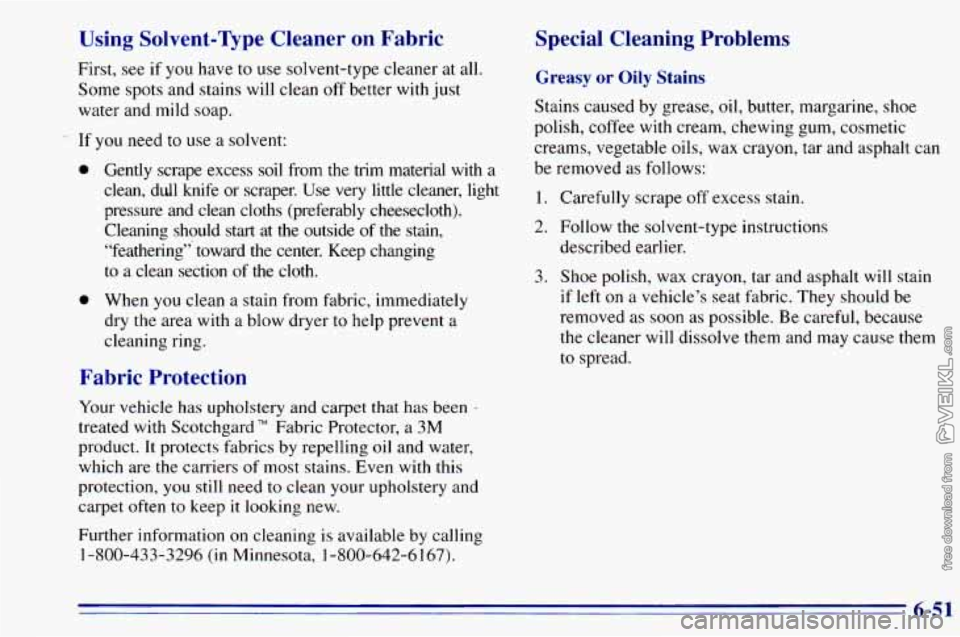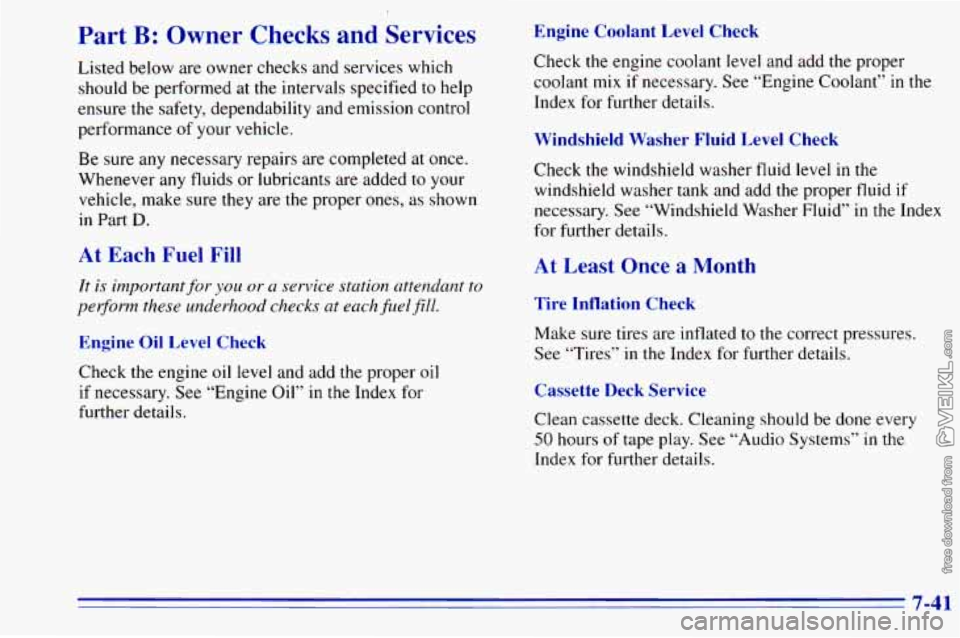1996 CHEVROLET ASTRO low oil pressure
[x] Cancel search: low oil pressurePage 120 of 372

Have you recently changed brands of fuel?
If
so, be sure to fuel your vehicle with quality fuel (see
“Fuel” in the Index).
Poor fuel quality will cause your
engine
not to run as efficiently as designed. You may
notice this as stalling after start-up, stalling when you
put the vehicle into gear, misfiring, hesitation
on
acceleration or stumbling on acceleration. (These
conditions may go away once the engine is warmed up.)
This will be detected by the system and cause the light
to turn
on.
If you experience this condition, change the fuel brand
you use. It will require at least
one full tank of the
proper
fuel to turn the light off.
If none
of the above steps have made the light turn off,
have your dealer or qualified service center check the
vehicle. Your dealer has
the proper test equipment and
diagnostic tools
to fix any mechanical or electrical
problems that may have developed.
Oil Pressure Gage
The oil pressure gage shows
the engine oil pressure in
psi (pounds per square inch)
when the engine
is running.
Canadian vehicles indicate pressure in kPa (kilopascals).
Oil pressure may vary
with engine speed, outside
temperature and oil viscosity, but readings above the
low pressure zone indicate the normal operating range.
A reading in the low pressure zone may be caused by a
dangerously low oil level or other problems causing
low
oil pressure.
2-60
Page 121 of 372

I A CAUTION:
Don’t keep driving if the oil pressure is low. If
you do, your engine can become so hot that it
catches fire.
You or others could be burned.
Check your oil as soon as possible and have
your vehicle serviced.
1 NOTICE:
Damage to your engine from neglected oil
problems can be costly and is not covered by
your warranty.
Check Oil Light
CHECK
OIL
This light should come
on briefly while
you are
starting your engine. If the
light doesn’t come
on, have
it repaired.
If the light comes on while starting and stays on, your
engine oil level should be checked.
Prior
to checking your oil level, be sure your vehicle is
on a level surface and has been shut off for several
minutes to allow the oil
to drain back into the oil pan.
Check your oil level and bring it up to the proper level.
See “Engine Oil” in
the Index.
The
oil level monitoring system only checks the oil
during the brief period between turning the key
on and
when the engine starts. It does
not check the oil level
while the vehicle is running.
Parking
on steep grades may cause the light to come on
even when the oil level is correct. If this happens, park
the vehicle
on a level surface and check the oil level.
2-61
Page 173 of 372

Once you are moving on the freeway, make certain you
allow a reasonable following distance. Expect to move
slightly slower at night.
When you want
to leave the freeway, move to the proper
lane well
in advance. If you miss your exit, do not,
under any circumstances, stop and back up. Drive on to
the next exit.
The
exit ramp can be curved, sometimes quite sharply.
The exit speed is usually posted.
Reduce your speed according to
your speedometer, not
to your sense of motion. After driving for any distance
at higher speeds, you may tend
to think you are going
slower than
you actually are.
Before Leaving on a Long Trip
Make sure you’re ready. Try to be well rested. If you
must start when you’re
not fresh -- such as after a day’s
work
-- don’t plan to make too many miles that first part
of the journey. Wear comfortable clothing and shoes
you
can easily drive in.
Is your vehicle ready for a long trip? If you keep it
serviced and maintained, it’s ready to go. If it needs
service, have it done before starting
out. Of course,
you’ll find experienced and able service experts
in GM
dealers all across North America. They’ll be ready and
willing
to help if you need it.
Here are some things you can check before a trip:
0
0
0
0
0
0
0
Windshield WcrslTer Fluid: Is the reservoir full? Are
all windows clean inside and outside?
Wiper Blades: Are they in good shape?
Fuel, Engine Oil, Other Fluids: Have you checked
all levels?
Lamps: Are they all working? Are the lenses clean?
Tires: They are vitally important to a safe,
trouble-free trip. Is the tread good enough for
long-distance driving? Are the tires all inflated to the
recommended pressure?
Weather Forecasts: What’s the weather outlook
along your route? Should you delay your trip a short
time to avoid
a major storm system?
Maps: Do you have up-to-date maps?
4-19
Page 281 of 372

Using Solvent-Type Cleaner on Fabric
First, see if you have to use solvent-type cleaner at all.
Some spots and stains will clean off better with just
water and mild soap.
-. If you need to use a solvent:
0 Gently scrape excess soil from the trim material with a
clean, dd1 knife or scraper. Use very little cleaner, light
pressure and clean cloths (preferably cheesecloth). Cleaning should start at the outside of the stain,
“feathering”’ toward
the center. Keep changing
to a clean section of the cloth.
0 When you clean a stain from fabric, immediately
dry the area with a blow dryer
to help prevent a
cleaning ring.
Fabric Protection
Your vehicle has upholstery and carpet that has been .
treated with Scotchgard“ Fabric Protector, a 3M
product.
It protects fabrics by repelling oil and water,
which are the carriers of most stains. Even
with this
protection, you still need to clean your upholstery and
carpet often to keep
it looking new.
Further information on cleaning is available by calling
1-800-433-3296
(in Minnesota, 1-800-642-61 67).
Special Cleaning Problems
Greasy or Oily Stains
Stains caused by grease, oil, butter, margarine, shoe
polish, coffee with cream, chewing gum, cosmetic
creams, vegetable oils, wax crayon,
tar and asphalt can
be removed as follows:
1. Carefully scrape off excess stain.
2. Follow the solvent-type instructions
described earlier.
3. Shoe polish, wax crayon, tar and asphalt will stain
if left on a vehicle’s seat fabric. They should be
removed as soon as possible.
Be careful, because
the cleaner will dissolve them and may cause them
to spread.
6-5 1
Page 295 of 372

Fuse
UPFIT-BATT .......
UPFIT-IGN . .
Spare .....
Fuse Puller*
Spare
.............
Spare .............
ECM-B ............
..
..
HORN ......
A/C COMP ...
RR DEFOG .......
ENG-I ......
IGN-E
..
..
Usage
Upfitter Battery
Power Stud, Trailer Wiring
Harness Upfitter Ignition Relay
Not Used
Not Used Not Used
Fuel Pump Relay,
VCM, Oil Pressure
Switch/Sender
Horn Relay
A/C Enable Relay
Heater-A/C Control Selector Switch
Oxygen Sensors 1-4,
Camshaft Position Sensor,
Mass Air Flow Sensor,
Evaporative Emission
Canister Purge Solenoid
Valve, Linear EGR Valve
Solenoid, VCM
A/C Enable Relay
Fuse
ECM-I ..... .....
LIGHTING .....
BATT I/P .......
IGN A .............
IGN B .............
ABS ..............
AIC ...............
RR HTR/AC ........
Spare .............
Usage
Fuel Injectors 1-6,
Crankshaft Position Sensor,
VCM, Distributor Ignition
Control Module Park Lamps Fuse,
DRL Fuse, Headlamp and
Panel Dimmer Switch
Fuse Block Fuses,
Power Seat CB,
Stop/Hazard Fuse,
Auxiliary Power Fuse,
Cigarette Lighter Fuse,
Radio, Battery Fuse
Starter Relay, Ignition Switch
Ignition Switch
Brake Pressure Module Valve Blower Motor Resistor,
Blower Relay
Auxiliary Heater A/C Relay
Not Used
* A fuse puller is included in the underhood electrical
center. You
will also find spare fuses.
6-65
Page 341 of 372

Part B: Owner Checks and Services
Listed below are owner checks and services which
should be performed at the intervals specified
to help
ensure the safety, dependability and emission control
performance of your vehicle.
Be sure
any necessary repairs are completed at once.
Whenever
any fluids or lubricants are added to your
vehicle, make sure they are the proper ones, as shown
in Part
D.
At Each Fuel Fill
It is important for you or a service station attendant to
perform these underhood checks at each
filelfill.
Engine Oil Level Check
Check the engine oil level and add the proper oil
if necessary. See “Engine Oil” in the Index for
further details.
Engine Coolant Level Check
Check the engine coolant level and add the proper
coolant mix if necessary. See “Engine Coolant” in the
Index for further details.
Windshield Washer Fluid Level Check
Check the windshield washer fluid level in the
windshield washer tank and add the proper fluid if
necessary. See “Windshield Washer Fluid”
in the Index
for further details.
At Least Once a Month
Tire Inflation Check
Make sure tires are inflated to the correct pressures.
See “Tires” in the Index for further details.
Cassette Deck Service
Clean cassette deck. Cleaning should be done every
50 hours of tape play. See “Audio Systems” in the
Index for further details.
7-41